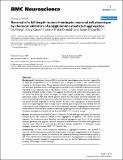| dc.contributor.author | Wang, Jin | |
| dc.contributor.author | Gines, Silvia | |
| dc.contributor.author | MacDonald, Marcy Elizabeth | |
| dc.contributor.author | Gusella, James Francis | |
| dc.date.accessioned | 2011-11-15T15:48:49Z | |
| dc.date.issued | 2005 | |
| dc.identifier.citation | Wang, Jin, Silvia Gines, Marcy E. MacDonald, and James F. Gusella. 2005. Reversal of a full-length mutant huntingtin neuronal cell phenotype by chemical inhibitors of polyglutamine-mediated aggregation. BMC Neuroscience 6: 1. | en_US |
| dc.identifier.issn | 1471-2202 | en_US |
| dc.identifier.uri | http://nrs.harvard.edu/urn-3:HUL.InstRepos:5345644 | |
| dc.description.abstract | Background: Huntington's disease (HD) is an inherited neurodegenerative disorder triggered by an expanded polyglutamine tract in huntingtin that is thought to confer a new conformational property on this large protein. The propensity of small amino-terminal fragments with mutant, but not wild-type, glutamine tracts to self-aggregate is consistent with an altered conformation but such fragments occur relatively late in the disease process in human patients and mouse models expressing full-length mutant protein. This suggests that the altered conformational property may act within the full-length mutant huntingtin to initially trigger pathogenesis. Indeed, genotype-phenotype studies in HD have defined genetic criteria for the disease initiating mechanism, and these are all fulfilled by phenotypes associated with expression of full-length mutant huntingtin, but not amino-terminal fragment, in mouse models. As the in vitro aggregation of amino-terminal mutant huntingtin fragment offers a ready assay to identify small compounds that interfere with the conformation of the polyglutamine tract, we have identified a number of aggregation inhibitors, and tested whether these are also capable of reversing a phenotype caused by endogenous expression of mutant huntingtin in a striatal cell line from the \(Hdh^{Q111/Q111}\) knock-in mouse. Results: We screened the NINDS Custom Collection of 1,040 FDA approved drugs and bioactive compounds for their ability to prevent in vitro aggregation of Q58-htn 1–171 amino terminal fragment. Ten compounds were identified that inhibited aggregation with \(IC_{50}\) < 15 μM, including gossypol, gambogic acid, juglone, celastrol, sanguinarine and anthralin. Of these, both juglone and celastrol were effective in reversing the abnormal cellular localization of full-length mutant huntingtin observed in mutant \(Hdh^{Q111/Q111}\) striatal cells. Conclusions: At least some compounds identified as aggregation inhibitors also prevent a neuronal cellular phenotype caused by full-length mutant huntingtin, suggesting that in vitro fragment aggregation can act as a proxy for monitoring the disease-producing conformational property in HD. Thus, identification and testing of compounds that alter in vitro aggregation is a viable approach for defining potential therapeutic compounds that may act on the deleterious conformational property of full-length mutant huntingtin. | en_US |
| dc.language.iso | en_US | en_US |
| dc.publisher | BioMed Central | en_US |
| dc.relation.isversionof | doi:10.1186/1471-2202-6-1 | en_US |
| dc.relation.hasversion | http://www.ncbi.nlm.nih.gov/pmc/articles/PMC548150/pdf/ | en_US |
| dash.license | LAA | |
| dc.title | Reversal of a Full-length Mutant Huntingtin Neuronal Cell Phenotype by Chemical Inhibitors of Polyglutamine-mediated Aggregation | en_US |
| dc.type | Journal Article | en_US |
| dc.description.version | Version of Record | en_US |
| dc.relation.journal | BMC Neuroscience | en_US |
| dash.depositing.author | Gusella, James Francis | |
| dc.date.available | 2011-11-15T15:48:49Z | |
| dash.affiliation.other | HMS^Genetics | en_US |
| dc.identifier.doi | 10.1186/1471-2202-6-1 | * |
| dash.contributor.affiliated | Gusella, James | |
| dash.contributor.affiliated | MacDonald, Marcy | |


